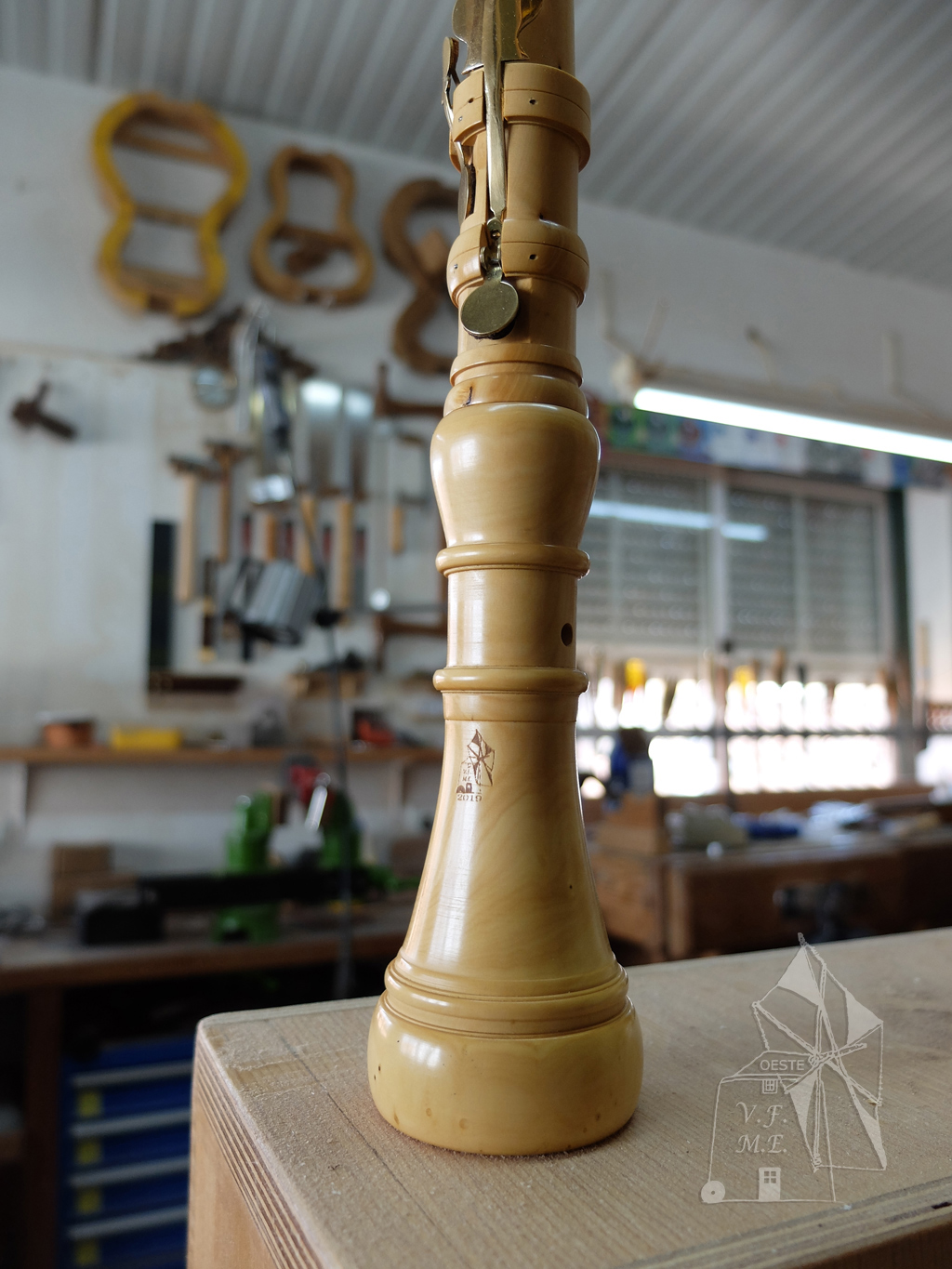Oboé barroco | Baroque oboe
Oboé barroco, modelo Eichentopf com afinação lá=415hz
Oboé barroco
A produção do oboé barroco cópia de Eichentopf surgiu como um desafio do oboísta Pedro Castro aos mestres construtores Mário Estanislau e Vitor Felix. A contínua busca por informação e inspiração na prática historicamente informada levou este especialista em instrumentos históricos ao Museu Nacional da Música onde o original deste instrumento está depositado. Tendo sido adquirido originalmente por Alfredo Keil, este exemplar acabou por ser doado a esta instituição, parte da importante colecção de instrumentos que o compositor realizou. Apesar existirem apenas dois originais de oboés de Eichentopf acessíveis em museus públicos (o outro encontra-se em Halle na Alemanha) a direcção do Museu Nacional da Música concedeu ao músico e aos construtores acesso ao instrumento, tendo tido assim a possibilidade comprovar as qualidades musicais e de realizar as medidas que permitiram realizar uma cópia fiel do instrumento.
O original aparenta ter sido um instrumento esteticamente humilde, mas feito para ser tocado e revela uma sonoridade ainda timbrada, doce e de emissão fácil em todo o registo. Com medidas de palhetas e tudel relativamente convencionais toca facilmente a 415Hz. Os problemas de afinação que surgem podem ser fruto da idade do instrumento e do facto de a maior parte dos originais com esta idade terem encolhido ligeiramente na zona do tubo mais estreita. Após vários protótipos e anos de experimentação entre o músico e os artesãos foi possível corrigir estas questões sem alterar o posicionamento e medidas dos buracos e com um ajuste mínimo à medida interior do instrumento, tendo-se chegado a um instrumento muito equilibrado e uma ferramenta capaz de fazer justiça ao mais diverso repertório do alto barroco.
Tendo Eichentopf sido contemporâneo e trabalhado em Leipzig quando J.S. Bach escreveu as suas grandes obras primas, é impossível não relacionar o legado destes dois importantes artistas. A verdade é que já é bastante comum a utilização de cópias de instrumentos deste construtor na interpretação de cantatas e oratórias de Bach, mas são quase sempre apenas os d’amore e da caccia. No Eichentopf de Lisboa há a particularidade de, ao contrário de muitos outros oboé originais da época, o buraco do fá ser duplo, largo e estar afastado o suficiente de forma a que a sonoridade do fá# é, sem grande esforço, significativamente equilibrada e afinada. Isto implica que o instrumentista que o utilizou na época tenha tido a capacidade técnica de lidar com dedilhações complexas e presumivelmente tenha havido a exigência, indissociável de J.S. Bach, de tocar com uma afinação bem temperada.
Sons da Música
Contacto
Baroque oboe
The production of the baroque oboe after Eichentopf started as a challenge from the oboist Pedro Castro to the luthiers Mario Estanislau and Victor Félix. The ongoing quest for information and inspiration in historical informed practice took this specialist in historical oboes to the Museu Nacional da Música where the original fo this model can be found. Having been acquired originally by Alfredo Keil in the 19th century, this instrument ended up in the main national instrument collection. Despite only two extant Eichentopf oboes being known nowadays to be accessible in public museums (the other one is in Halle, Germany), the Museum granted access to the makers and the oboist to the instrument, having had the possibility of testing its musical qualities and taking the necessary measurements in order to reproduce a faithful copy.
The original appears to be an esthetically humble instrument, but having been produced to be used as a competent musical tool, revealing a balanced, focused and sweet tone that easily speaks in the whole register. With conventional baroque oboe reed and staple measurements plays confortably at 415hz. The tunning issues that arise can be due the wood shrinkage that usually affects boxwood instruments of this age and that are particularly important in the narrower section of the bore. After several prototypes and years of subtle adjustments worked out between the makers and the player, it was possible to deal with this issues with minor bore adjustments and without changing the hole size and position. Today’s model is an inspiring, well balanced instrument, capable of dealing with the most diverse repertoire of the high baroque.
Eichentopf lived and worked Leipzig in the period J.S. Bach also lived there and wrote the bulk of his legacy and masterpieces. It is therefore impossible not to consider a relation between the work of these two artists. In fact it is already quite common the usage of Eichentopf copies in the interpretation of Bach oratorio and cantatas, but that is usually only in the d’amore and caccias the maker is also famous for. In the Lisbon Eichentopf it is notable the fact that, not like many baroque and classical originals, the “f” has confortably spaced double holes in order to be able to play clear and well tuned low f sharps with little correction effort. This implies that the musician that used this instrument at the time has had the technical ability to deal with complex fingerings and that presumably, the production of this instrument had the influence of J. S. Bach demanding well tempered chromatic capabilities in the whole range of the instrument.
Sons da Música
Contact











